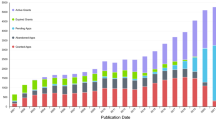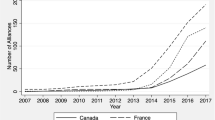Abstract
I study licensing and technology choice in standard setting. I find that there may be inefficient adoption of technologies, even when firms commit to a maximum royalty or price cap for the use of their patents. When firms interact repeatedly to develop standards, a commitment to set fair, reasonable and non-discriminatory (FRAND) royalty fees may lead to more efficient technologies and higher surplus for all parties. This result can explain why standard-setting organizations favor FRAND commitments over more structured licensing commitments—such as price caps—and why there are been relatively few cases of hold-up in practice, even though such opportunistic behavior has been a primary cause of concern for innovation economists.

Similar content being viewed by others
Notes
Standards involve complementary technologies from several firms, which make it difficult to assess which specification of the standard would be optimal ex ante, even if all firms offer price caps and even if there is perfect information about the relevant patents that are held by each firm.
In the real world, the existence of a FRAND commitment and the option of taking the patent holder to court may provide additional constraints on opportunistic behavior.
Larouche and Schuett (2017) study a repeated model of standard setting, but they focus on the voting rules of SSOs, not on the comparison between different licensing rules.
SSOs can often choose between two or more technologies when developing a standard. For example, in the case of the 802.11g (Wi-Fi) standard, IEEE had to choose between the Orthogonal Frequency Division Multiplexing (OFDM) and Packet Binary Convolution Coding (PBCC) technologies, which were sponsored by Intersil and Texas Instruments respectively (see for details DeLacey et al. 2006).
The paper can be extended in a straightforward manner to allow for competition between patented technologies.
It is straightforward to extend the model to include a cost of reverting technology choices. The main results of the paper will hold as long as this cost is sufficiently large. If the cost is small, hold-up is not a significant problem, and technological decisions are efficient.
The low outcome for technology 1 is assumed to be equal to technology 0’s value for simplicity. The assumption is not essential for the paper’s results: Analogous results would be obtained if the low outcome for technology 1 was greater or smaller than \({\underline{v}}\) (although, of course, the bounds in Propositions 1 to 3 would have to be adapted).
The traditional model of hold-up obtains if \(\alpha = 0\), in which case the standard is selected solely taking into account users’ utility, who expect full appropriation of value by the firm. All results in the paper hold if \(\alpha = 0\), but it is also interesting to study comparative statics results as \(\alpha\) changes.
Choosing a price cap that is larger than \({\overline{v}}\) is equivalent to refusing to set a price cap. This action could also be interpreted as the firm’s leaving the SSO. However, leaving the SSO may also affect the firm’s bargaining power in the SSO. Leaving the SSO has the same effect as refusing to set a price cap if the firm’s bargaining power is unaffected.
Following complaints by Ericsson, Nokia, Texas Instruments, Broadcom, NEC, and Panasonic that Qualcomm was setting excessively large royalty fees, the European Commission opened proceedings against Qualcomm. As the investigation was being carried out, all complainants withdrew or indicated their intention to withdraw their complaints, after which the Commission ended its probe. As this example shows, in practice it is difficult to prove that hold-up is taking place and that licensing fees are unreasonable from an ex ante perspective.
Clearly, the standard-setting process is dynamic but non stationary, as technologies evolve and firms interact in different standards. The assumption of stationarity is a simplifying assumption only made to focus on the implications of repeated interaction among SSO’s members. Similar results can be obtained in a non-stationary dynamic model.
This probability may be related with the breadth of the patent portfolio of the firm. Firms that focus on developing few technologies have a smaller probability of being involved in future standard-setting efforts.
In a roundtable organized by the DOJ and the FTC (Farrell et al. 2002), Joseph Kattan (who was a partner in Gibson, Dunn & Crutcher) stated that hold-up “has happened, but it doesn’t happen very often” (p. 21); and Paul Vishny (who was a member of D’Ancona & Pflaum, and General Counsel of the Telecommunications Industry Association) stated that hold-up is “not the kind of problem we have seen at TIA in the 600 some standards, and it’s not the kind of problem that my colleagues that I’ve spoken to have seen in the course of their standard formulation activities” (p. 24).
The SSO and the firm could introduce a price cap larger than \({\overline{v}}\) in their relational contract, in which case the price cap would not be effective, and the results would be analogous to those of Sect. 7. Thus, introducing a price cap in the repeated game can only improve the outcome of the repeated game without price caps.
Many companies send only technical specialists to standard-setting committees, and refrain from sending lawyers, given that the IP recognition and negotiation process is very slow compared to the selection of the appropriate technologies from a technical point of view. In the DOJ-FTC roundtable mentioned above, Earle Thompson, Intellectual Asset Manager and Senior Counsel at Texas Instruments, said: “Most of these standards move fairly rapidly. It takes much longer to get through the patent office” (Farrell et al. 2002).
This result obtains for any positive cost of writing ex-ante contracts, no matter how small.
References
Aghion, P., & Tirole, J. (1994). The management of innovation. The Quarterly Journal of Economics, 109(4), 1185–1209.
DeLacey, B. J., Herman, K., Kiron, D., & Lerner, J. (2006). Strategic behavior in standard-setting organizations. Working paper, Harvard Business School.
Farrell, J., Hayes, J., Shapiro, C., & Sullivan, T. (2007). Standard setting, patents, and hold-up. Antitrust Law Journal, 74, 603.
Farrell, J., Kattan, J., Peterson, S., Shapiro, C., Thompson, E., & Vishny, P. (2002). Standard setting organizations: Evaluating the anticompetitive risks of negotiating IP licensing terms and conditions before a standard is set. In Federal Trade Commission and Department of Justice Antitrust Division roundtables: Competition and IP law and policy in the knowledge based economy. November 6, Washington, DC. https://www.ftc.gov/sites/default/files/documents/public_events/competition-ip-law-policy-knowledge-based-economy-hearings/021106ftctrans.pdf. Accessed 13 July 2018.
Farrell, J., & Simcoe, T. (2012). Choosing the rules for consensus standardization. RAND Journal of Economics, 43(2), 235–252.
Joshi, A. M., & Nerkar, A. (2011). When do strategic alliances inhibit innovation by firms? Evidence from patent pools in the global optical disc industry. Strategic Management Journal, 32(11), 1139–1160.
Larouche, P., & Schuett, F. (2017). Repeated interaction in standard setting. Working paper.
Layne-Farrar, A., Llobet, G., & Padilla, J. (2014). Payments and participation: The incentives to join cooperative standard setting efforts. Journal of Economics and Management Strategy, 23(1), 24–29.
Lerner, J., & Tirole, J. (2006). A model of forum shopping. American Economic Review, 96(4), 1091–1113.
Lerner, J., & Tirole, J. (2015). Standard-essential patents. Journal of Political Economy, 123(3), 547–586.
Llanes, G., & Poblete, J. (2014). Ex-ante agreements in standard setting and patent-pool formation. Journal of Economics and Management Strategy, 23(1), 50–67.
Schmalensee, R. (2009). Standard-setting, innovation specialists and competition policy. Journal of Industrial Economics, 57(3), 526–552.
Schmidt, K. M. (2008). Complementary patents and market structure. CEPR Discussion Paper.
Shapiro, C. (2001). Navigating the patent thicket: Cross licenses, patent pools, and standard setting. In A. B. Jaffe, J. Lerner, & S. Stern (Eds.), Innovation policy and the economy (Vol. 1, pp. 119–150). Cambridge: MIT Press.
Simcoe, T. (2012). Standard setting committees: Consensus governance for shared technology platforms. American Economic Review, 102(1), 305–336.
Updegrove, A. (2003). Survey: Major standards players tell how they evaluate standard setting organizations. Consortium Standards Bulletin, 2(6). http://www.consortiuminfo.org/bulletins/pdf/jun03/survey.pdf. Accessed 13 July 2018.
Acknowledgements
A previous version of the paper circulated under the name “Licensing rules and technology choice in Standard Setting Organizations.” I am grateful to Stefano Trento, Francisco Ruiz-Aliseda, and participants of seminars at the 2011 EARIE Conference (Stockholm, Sweden), the 2011 LACEA-LAMES Conference (Santiago, Chile), Universitat Autònoma de Barcelona, Universidad de Santiago de Chile, and Universidad Alberto Hurtado for useful comments and suggestions. I gratefully acknowledge financial support from Conicyt (Fondecyt No. 1150326) and the Institute for Research in Market Imperfections and Public Policy, MIPP, ICM IS130002, Ministerio de Economía, Fomento y Turismo.
Author information
Authors and Affiliations
Corresponding author
Appendix: Proofs
Appendix: Proofs
Proof of Proposition 1
Suppose technology 0 is used: Then, consumer surplus is \(\underline{v}\), firm profit is 0, and SSO welfare is \(W = {\underline{v}}\).
Suppose technology 1 is used: In the third stage, given realization v, firm chooses price \(p = v\). In the second stage, the firm chooses x to maximize \(x \, {\overline{v}} + (1-x) \, {\underline{v}} - \frac{1}{2} \, x^2\), which yields \(x^* = ({\overline{v}} - \underline{v})\). Expected quality is \({\underline{v}} + ({\overline{v}} - \underline{v})^2\), firm profits are \({\underline{v}} + \frac{1}{2} \, ({\overline{v}} - {\underline{v}})^2\), consumer surplus is 0, and SSO welfare is \(U = \alpha \, \left( {\underline{v}} + \frac{1}{2} \, ({\overline{v}} - {\underline{v}})^2 \right)\).
The SSO chooses technology 1 if and only if
Proof of Proposition 2
Suppose \(\varDelta < 2 \, \frac{1-\alpha }{\alpha }\) so technology 0 is chosen in the absence of price caps. We want to find an equilibrium with \({\underline{v}} \le {\overline{p}} \le {\overline{v}}\).
Suppose the SSO chooses technology 1: In the fourth stage, if the realization is \({\underline{v}}\), the firm charges \(p = {\underline{v}}\); and if the realization is \({\overline{v}}\), the firm charges \(p = {\overline{p}}\). In the third stage, the firm chooses x to maximize \(x \, {\overline{p}} + (1-x) \, {\underline{v}} - \frac{1}{2} \, x^2\), which yields \(x^* = {\overline{p}} - {\underline{v}}\). Expected quality is \({\underline{v}} + ({\overline{p}} - {\underline{v}}) \, ({\overline{v}} - {\underline{v}})\), firm profits are \({\underline{v}} + \frac{1}{2} \, ({\overline{p}} - {\underline{v}})^2\), consumer surplus is \(({\overline{p}} - {\underline{v}}) \, ({\overline{v}} - {\overline{p}})\), and SSO welfare is \(U = ({\overline{p}} - {\underline{v}}) \, ({\overline{v}} - {\overline{p}}) + \alpha \, \left({\underline{v}} + \frac{1}{2} \, ({\overline{p}} - \underline{v})^2 \right)\).
In the second stage, the SSO will choose technology 1 if
In the first stage, the firm will choose the largest price cap possible so that the SSO chooses technology 1, which is
If \(({\overline{v}} - {\underline{v}})^2 - 2 \, {\underline{v}} \, \left( 2 - \alpha \, (3-\alpha ) \right) < 0\), then there is no price cap such that the SSO chooses technology 1. Therefore, for technology 1 to be adopted, we need
Proof of Proposition 3
The firm can deviate in the second or third stages. In the third stage, if the realization is \({\overline{v}}\), the firm does not deviate as long as
If the realization is \({\underline{v}}\), the firm does not deviate as long as
Multiplying the left- and right-hand sides of (1) by \(\widehat{x}\) and the left and right hand sides of (2) by \(1-{\widehat{x}}\), and adding the resulting inequalities, I obtain
In the second stage, the firm does not deviate as long as
which is equivalent to (3).
The SSO does not deviate as long as
There exists \({\widehat{r}}\) that is consistent with (4) and (5) as long as
Rights and permissions
About this article
Cite this article
Llanes, G. Ex-ante Agreements and FRAND Commitments in a Repeated Game of Standard-Setting Organizations. Rev Ind Organ 54, 159–174 (2019). https://doi.org/10.1007/s11151-018-9647-7
Published:
Issue Date:
DOI: https://doi.org/10.1007/s11151-018-9647-7
Keywords
- Standard formation
- Standard-setting organizations
- Hold-up
- Price caps
- FRAND commitments
- Repeated games
- Relational contracts




